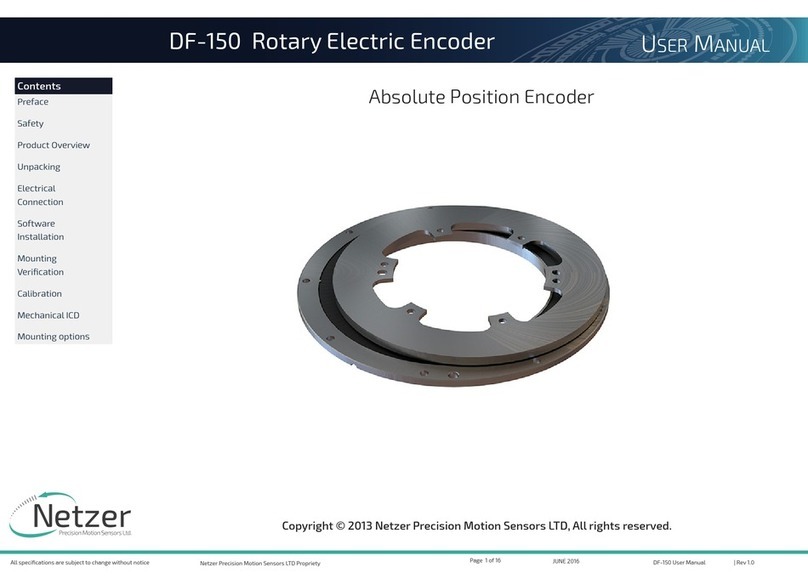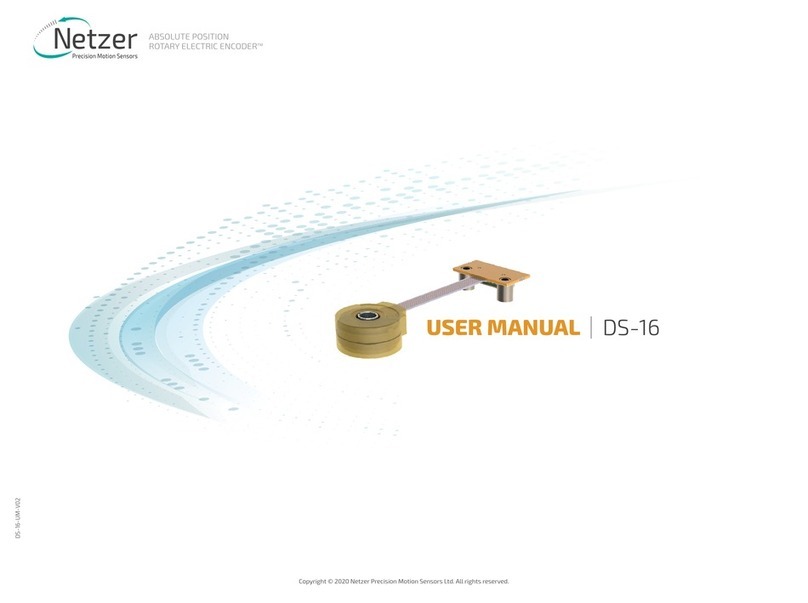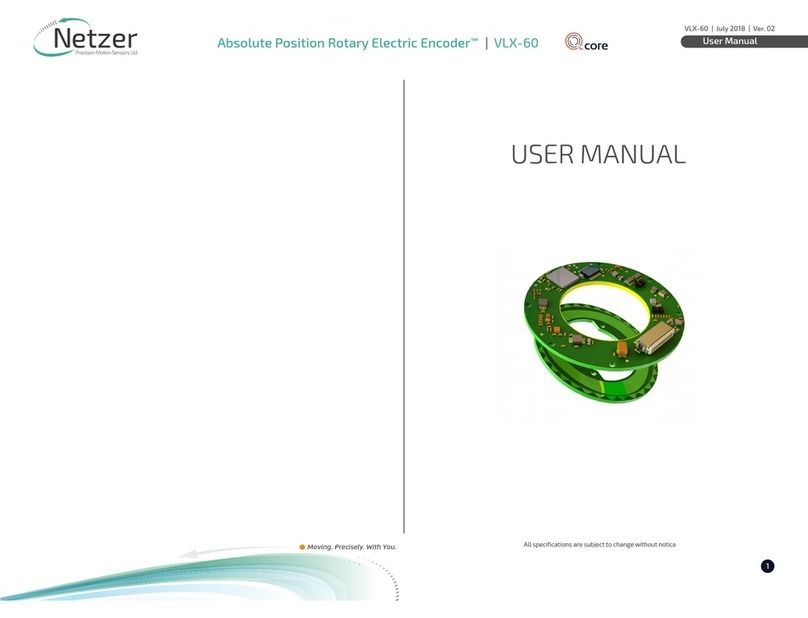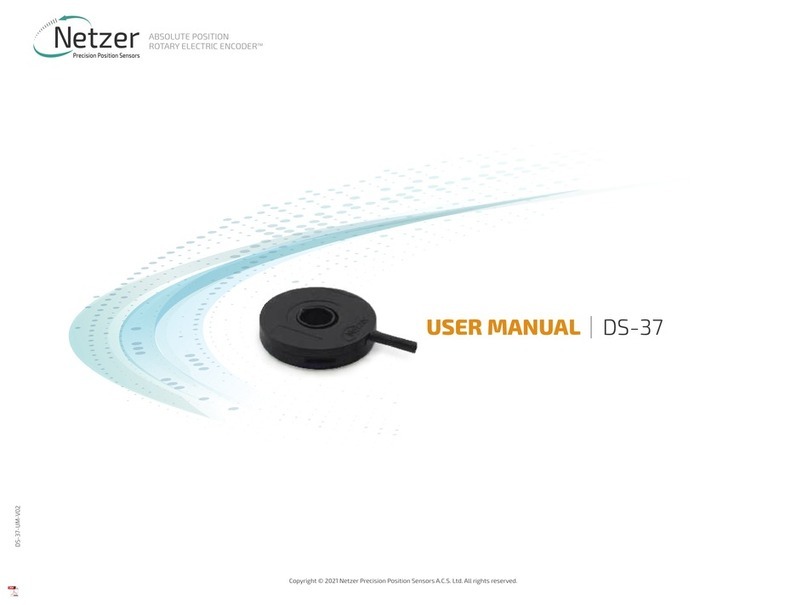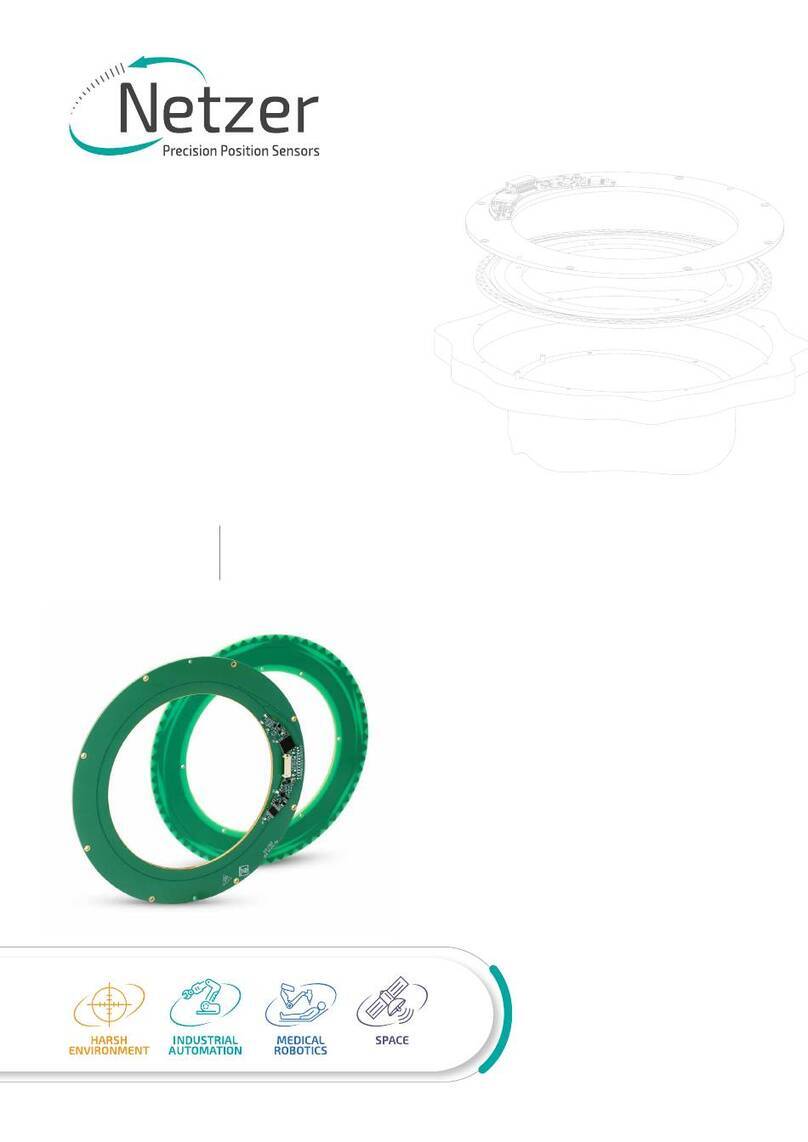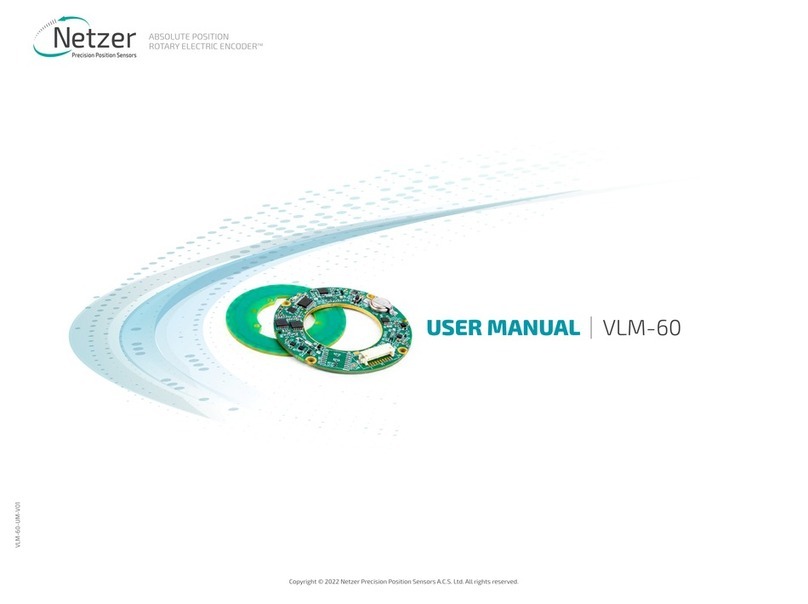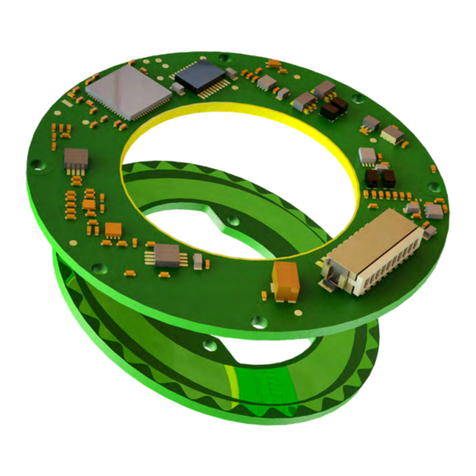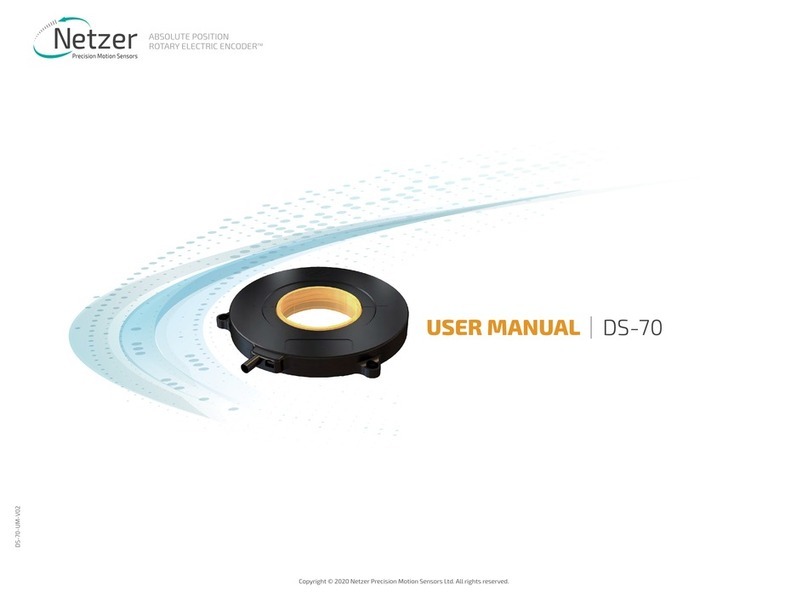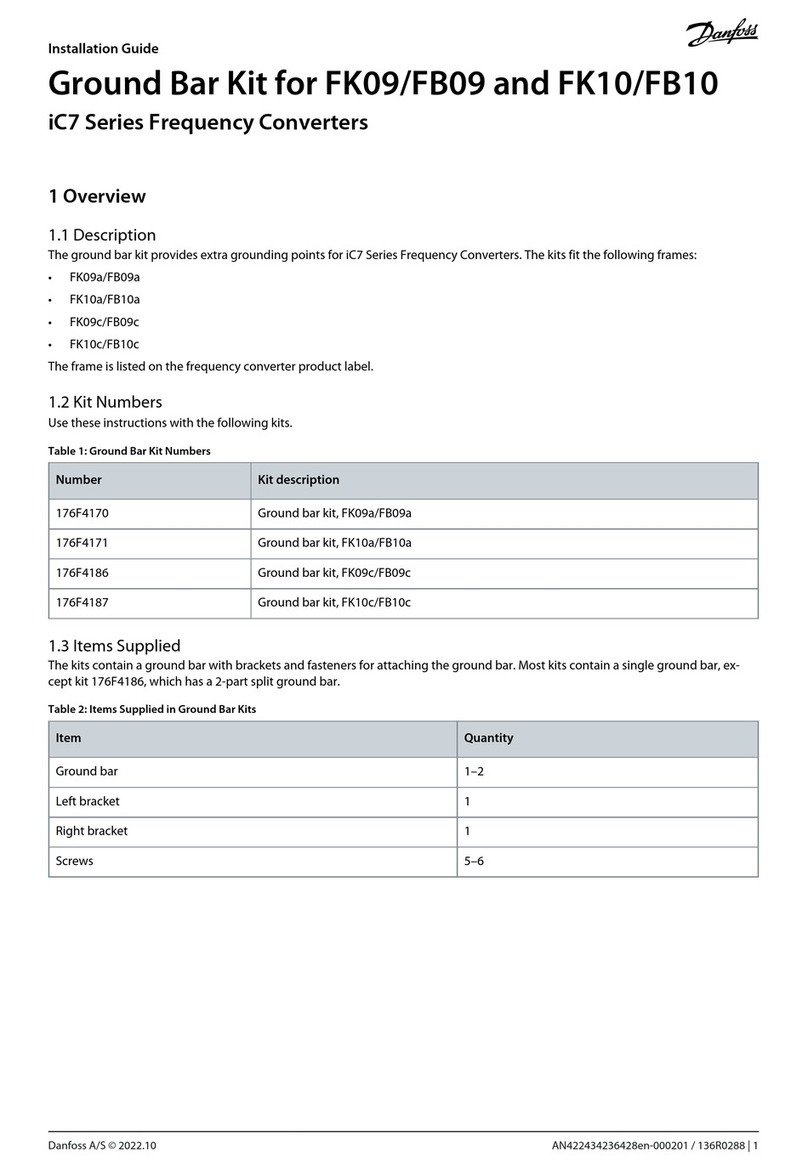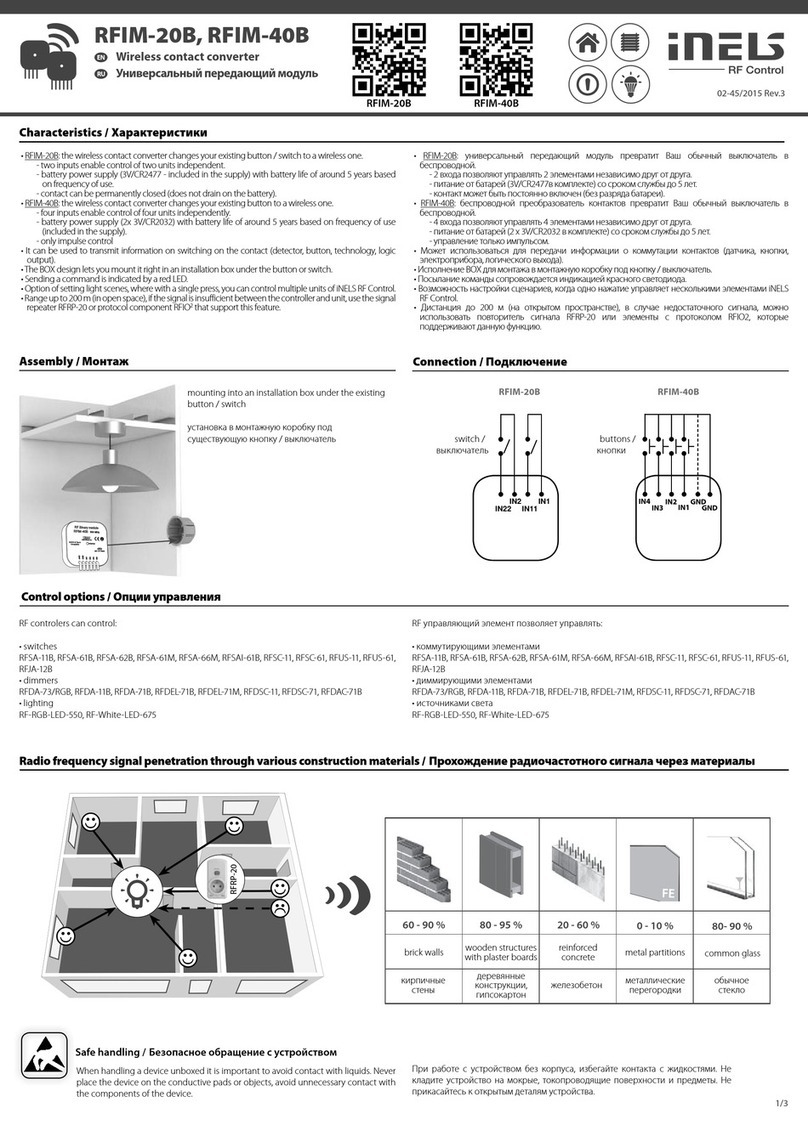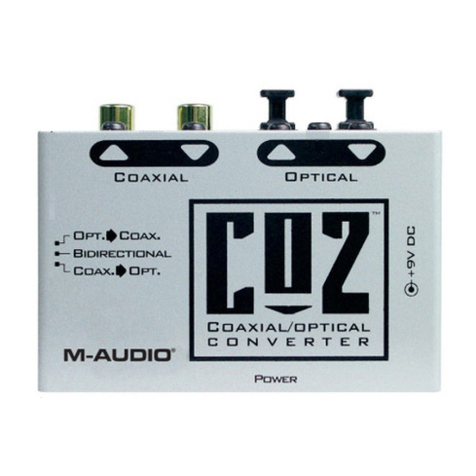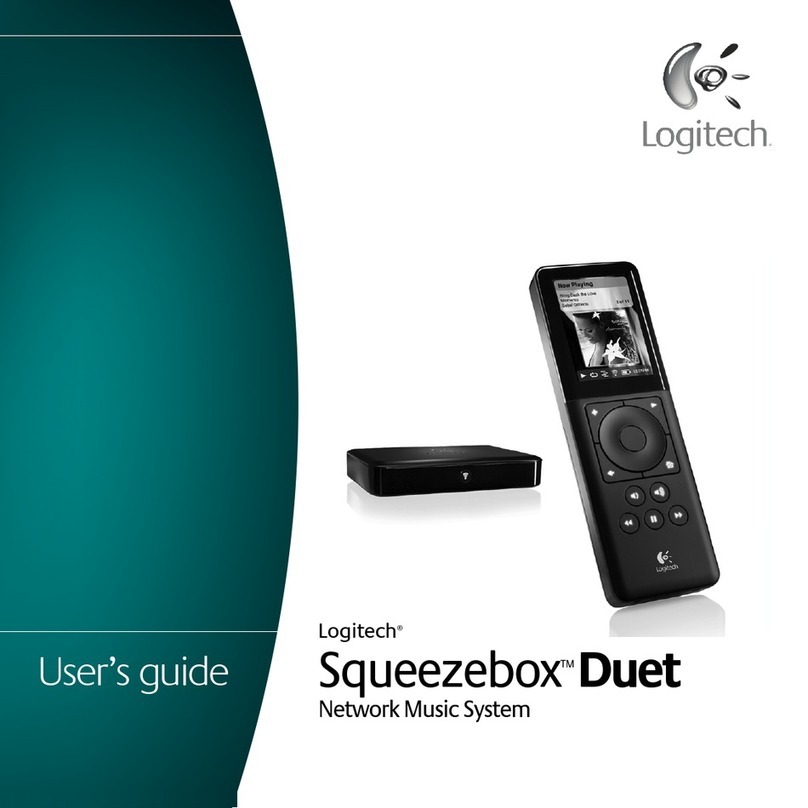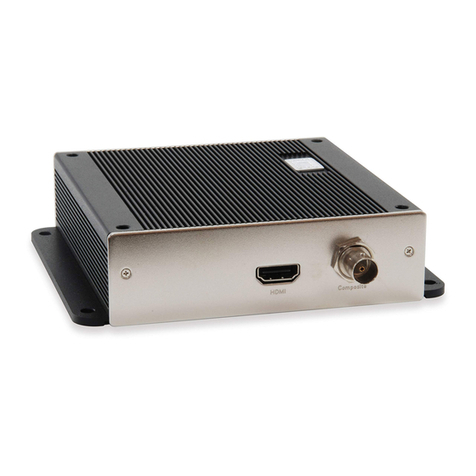Netzer VLR-100 User manual

VLR-100
PRODUCT GUIDE
Hollow Shaft
Kit Encoder
Absolute
Rotary Encoder
www.electromate.com
ELECTROMATE
Toll Free Phone (877) SERVO98
Toll Free Fax (877) SERV099
www.electromate.com
Sold & Serviced By:


PRODUCT GUIDE
VLR-100
Hollow Shaft
Kit Encoder
Absolute
Rotary Encoder
Table of Contents
1. VLR Encoders Introduction ...............................................................................................................................................4
2. Technical Specifications.....................................................................................................................................................5
3. Ordering Code.......................................................................................................................................................................6
4. Mechanical Drawings..........................................................................................................................................................7
5. Mechanical Interface Control Drawing.........................................................................................................................8
6. Storage and Handling.........................................................................................................................................................9
7. ESD Protection.......................................................................................................................................................................9
8. Product Overview ......................................................................................................................................................... 9-10
8.1 Overview........................................................................................................................................................................................................9
8.2 Unpacking - Standard order ..........................................................................................................................................................10
8.3 Installation flow chart .........................................................................................................................................................................10
9. Electric Encoder Software Installation.......................................................................................................................11
9.1 Minimum requirements ....................................................................................................................................................................11
9.2 Installing the software........................................................................................................................................................................11
10. Mechanical Mounting................................................................................................................................................11-12
10.1 Encoder mounting - End-of-Shaft Installation .................................................................................................................... 11
11. Electrical Connection.................................................................................................................................................13-16
11.1 Absolute position over SSi or BiSS-C .........................................................................................................................................13
11.2 Digital SSi Interface............................................................................................................................................................................... 14
11.3 Digital BiSS-C Interface.......................................................................................................................................................................15
11.4 Setup mode over NCP (Netzer Communication Protocol).......................................................................................... 16
11.5 Electrical connection and grounding.......................................................................................................................................16
12. Signal Verification........................................................................................................................................................17-19
12.1 Starting the Encoder Explorer........................................................................................................................................................17
12.2 Signal verification process................................................................................................................................................................18
13. Calibration......................................................................................................................................................................20-28
13.1 Auto-calibration......................................................................................................................................................................................20
13.2 Manual calibration ................................................................................................................................................................................23
13.3 Setting the encoder zero-position.............................................................................................................................................. 27
13.4 Jitter test......................................................................................................................................................................................................28
14. Operational Mode.............................................................................................................................................................29
9.1 SSi / BiSS ...................................................................................................................................................................................................... 29

4Product GuideVLR-100-PG-V01
1. VLR Encoders Introduction
Designed to meet the requirements of the most demanding applications
The VLR series of Electric Encoders™ are a line of encoders designed to meet the needs of various industries,
especially in extreme environments from defense to heavy machinery.
The VLR series is engineered for high durability, It is a non-contact, low-maintenance, and easy-to-install
solution. The capacitive technology ensures dependable performance, which is crucial for industries that
operate under tough conditions.
These encoders are based on capacitive technology developed and improved for over 20 years by Netzer
Precision Position Sensors.
The VLR encoders are characterized by the following features that sets them apart from
other similar encoders:
●Low profile (<12.5 mm)
●Hollow shaft (Stator / Rotor)
●No bearings or other contact elements
●High resolution and excellent precision
●Immunity to magnetic fields
●High reliability in extreme environments
●Durability and ease of installation
●High tolerance to temperature extremes, shock, moisture, EMI, RFI
●Holistic signal generation and sensing
●Digital interfaces for absolute position
The holistic structure of the VLR Electric Encoder™ makes it unique. Its output reading is the averaged outcome
of the entire circumference area of the rotor. This inherent design characteristic provides the VLR encoder with
outstanding precision as well as a tolerant mechanical mounting.
The absence of components such as ball bearings, flexible couplers, glass discs, light sources & detectors, along
with very low power consumption, enables the VLR encoders to deliver virtually failure-free performance.

PRODUCT GUIDE
5
Netzer Precision Position Sensors
VLR-100
Hollow Shaft
Kit Encoder
Absolute
Rotary Encoder
VLR-100-PG-V01
2. Technical Specications
General
Angular resolution 18-20 bit
Nominal position accuracy ±0.006°
Maximum operational speed 4,000 rpm
Measurement range Single turn, unlimited
Rotation direction Adjustable CW/CCW*
Built In Test BIT Optional
* Default same direction from bottom side of the encoder
Mechanical
Allowable mounting eccentricity ±0.15 mm
Allowable axial mounting tolerance
±0.15 mm
Rotor inertia 51,191 gr · mm2
Total weight 178 gr
Outer Ø / Inner Ø / Height 105 / 53 / 12.5 mm
Housing Aluminum
Nominal air gap (stator, rotor) 0.8 mm
Electrical
Supply voltage 5V ± 5%
Current consumption ~90 mA
Interconnection Cable (standard 250mm)
Communication SSi, BiSS-C
Output code Binary
Serial output Dierential RS-422
Clock frequency 0.1- 5.0 MHz
Position update rate 35 kHz (Optional - up to 375 kHz)
Environmental
EMC IEC 6100-6-2, IEC 6100-6-4
Operating temperature -40°C to +85°C
Storage temperature -55°C to +125°C
Relative humidity 98% Non condensing
Shock endurance / functional 100g 6msec saw-tooth per IEC 60068-2-27:2009
40g 11msec saw-tooth per MIL-810G
Vibration functional 7.7grms @ 20 to 2000 Hz per MIL-810G Category 24
Protection IP 40

6Product GuideVLR-100-PG-V01
3. Ordering Code
Custom
Cable Length
0250 mm Flying leads - 30AWG
1500 mm Flying leads - 30AWG
2750 mm Flying leads - 30AWG
31000 mm Flying leads - 30AWG
4250 mm Flying leads - 28AWG
5500 mm Flying leads - 28AWG
6750 mm Flying leads - 28AWG
71000 mm Flying leads - 28AWG
To add a connector contact us
Cable Options
SJacket and shielded cable
VLR -100 -S G -S 0 -nnnn
VLR Product Line
Outer Diameter
Output
SSSi
IBiSS
Resolution
Code Bit CPR
G18 262,144
H19 524,288
I20 1,048,578
BIT (Built In Test): Optional
[ ] None
BBIT
www.electromate.com
ELECTROMATE
Toll Free Phone (877) SERVO98
Toll Free Fax (877) SERV099
www.electromate.com
Sold & Serviced By:

PRODUCT GUIDE
7
Netzer Precision Position Sensors
VLR-100
Hollow Shaft
Kit Encoder
Absolute
Rotary Encoder
VLR-100-PG-V01
4. Mechanical Drawings
Unless otherwise specied
Dimensions are in: mm Surface nish: N6
Linear tolerances
0.5-4.9: ±0.05 mm 5-30: ±0.1 mm
31-120: ±0.15 mm 121-400: ±0.2 mm
53.0
Rotor ID
88.0
Rotor OD
105.0
Stator OD
58.0
Stator ID
110.0
Stator mounting PCD
3 Threads M2
5 mm
Equal spacing
48.0
Rotor mounting PCD
3 Threads M2
5 mm
Equal spacing
Notes
1. Due to PCB’s inherent manufacturing tolerances, Netzer recommends the use of shims in order to achieve air gap.
Pair# Color
A1-A2 Red / Black
A3-A4 Gray / Blue
A5-A6 Green / Yellow
Cable options
Netzer Cat No. CB 00014 CB 00034
Cable type 30 AWG twisted pair x 3 28 AWG twisted pair x 3
Wire type 30 AWG 25/44 Tinned copper
Insulation: PFA Ø 0.15
OD: Ø 0.6 ± 0.05 mm
28 AWG 40/44 Tinned copper
Insulation: PFA Ø 0.12
OD: Ø 0.64 ± 0.05 mm
Temp. Rating -55°C to +150°C
Braided shield Thinned copper braided 95% min. coverage
Jacket 0.45 silicon rubber (NFA 11-A1) 0.44 silicon rubber (NFA 11-A1)
Diameter Ø 3.45 ± 0.16 mm Ø 3.53 ± 0.16 mm
A1
A2
28 AWG twisted pairs x3
Braid shield
Jacket 0.44 mm
Ø 3.53 ±0.16 mm
30AWG twisted pairs x3
Braid shield
Jacket 0.45 mm
Ø 3.45 ±0.16 mm

8Product GuideVLR-100-PG-V01
5. Mechanical Interface Control Drawing
Unless otherwise specied
Dimensions are in: mm Surface nish: N6
Linear tolerances
0.5-4.9: ±0.05 mm 5-30: ±0.1 mm
31-120: ±0.15 mm 121-400: ±0.2 mm
Encoder's stator
Encoder's rotor
Customer's base
Customer's shaft
Mounting clamps
1.50 ±0.05
1.50 ±0.05
0.3 x 45° Max
0.3 x 45° Max
0.03
0.03
A
0.03
A
12.5
Notes
1. Other than the mount, allow at least 1 mm gap under
the rotor, free of any metal.

PRODUCT GUIDE
9
Netzer Precision Position Sensors
VLR-100
Hollow Shaft
Kit Encoder
Absolute
Rotary Encoder
VLR-100-PG-V01
8. Product Overview
8.1 Overview
The VLR-100 absolute position Electric Encoder™ is a rotary position sensor developed for demanding
applications. Currently it performs in a broad range of applications, including defense, homeland security,
medical robotics and industrial automation.
The Electric Encoder™ non-contact technology provides accurate position measurement through the
modulation of an electric field.
The VLR-100 Electric Encoder™ is a kit-encoder, i.e., its rotor and stator are separate.
7. ESD Protection
As usual for electronic circuits, during product handling do not touch electronic circuits, wires, connectors or
sensors without suitable ESD protection. The integrator / operator shall use ESD equipment to avoid the risk
of circuit damage.
6. Storage and Handling
Storage temperature: -55°C to +125°C
Humidity: Up to 98% non-condensing
ATTENTION OBSERVE PRECAUTIONS FOR HANDLING
ELECTROSTATIC SENSITIVE DEVICES
(1) Encoder stator
(2) Encoder rotor
1
2

10 Product GuideVLR-100-PG-V01
8.2 Unpacking - Standard order
The package of the standard VLR-100 contains the encoder Stator & Rotor
.
Optional accessories:
(1) CNV-00003 (Blue Box), RS-422 to USB converter (with USB internal 5V power supply path).
(2) NanoMIC-KIT-01, RS-422 to USB converter. Setup & Operational modes via SSi /BiSS interface.
(3) RJ-VLR-100 - rotary jig
(4) DKIT-VLR-100-SG-S0, Mounted SSi encoder on rotary jig, RS-422 to USB converter and cables.
(5) DKIT-VLR-100-IG-S0, Mounted BiSS encoder on rotary jig, RS-422 to USB converter and cables.
8.3 Installation ow chart
Calibration Mounting
correction
YES NO
Mechanical
Mounting
Signal
verication
Electric Encoder
Software
installation on PC
Electrical
connection

PRODUCT GUIDE
11
Netzer Precision Position Sensors
VLR-100
Hollow Shaft
Kit Encoder
Absolute
Rotary Encoder
VLR-100-PG-V01
9. Electric Encoder Software Installation
The Electric Encoder Explorer (EEE) software:
●Verifies correct mounting for an adequate signal amplitude
●Calibration of offsets
●General set up and signal analysis
This section describes the steps associated with installing the EEE software application.
9.1 Minimum requirements
●Operating system: MS windows 7/ 10, (32 / 64 bit)
●Memory: 4MB minimum
●Communication ports: USB 2
●Windows .NET Framework, V4 minimum
9.2 Installing the software
●Run the Electric Encoder™ Explorer file found on Netzer website: Encoder Explorer Software Tools
●After the installation you will see Electric Encoder Explorer software icon on the computer desktop.
●Click on the Electric Encoder Explorer software icon to start.
10. Mechanical Mounting
10.1 Encoder mounting - End-of-Shaft Installation
Typical encoder installation uses
●The Mounting clamps EAPK005, 3 each per stator & rotor are included.
●There are 6 mounting slots in the rotor and stator, 3 upper slots and 3 lower slots.
The user can define the type of installation direction while using the upper or lower slots.
Mounting slots
Mounting clamps

12 Product GuideVLR-100-PG-V01
Encoder stator / Rotor relative position
For proper performance, the stator and rotor mounting surfaces should be coplanar.
Note: for more information please read section 7
In an optimal mounting, the signal amplitude values generated by the encoder, would be in the middle of the
range of the signal plot shown in the Encoder Explorer software (see plot below). This may vary according to
the encoder type.
Verify proper rotor mounting with the Encoder Explorer tools “Signal analyzer” or “Signal verification process.”
www.electromate.com
ELECTROMATE
Toll Free Phone (877) SERVO98
Toll Free Fax (877) SERV099
www.electromate.com
Sold & Serviced By:

PRODUCT GUIDE
13
Netzer Precision Position Sensors
VLR-100
Hollow Shaft
Kit Encoder
Absolute
Rotary Encoder
VLR-100-PG-V01
11. Electrical Connection
This chapter reviews the steps required to electrically connect the encoder with digital interface (SSi or BiSS-C).
Connecting the encoder
The encoder has two operational modes:
11.1 Absolute position over SSi or BiSS-C
This is the power-up default mode
5V
Host System
CLK / NCP RX [+]
CLK / NCP RX [-]
5V
5V
120 Ω
(red)
(yellow)
(green)
(blue)
(gray)
(black)
Electric Encoder™
Gnd
DATA / NCP TX [-]
DATA / NCP TX [+]
SSi / BiSS interface wires color code
Clock + Grey Clock
Clock - Blue
Data - Yellow Data
Data + Green
GND Black Ground
+5V Red Power supply
SSi / BiSS output signal parameters
Output code Binary
Serial output Dierential RS-422
Clock Dierential RS-422
Clock frequency 0.1 ÷ 5.0 MHz
Position update rate 35 kHz (Optional - up to 375 kHz)

14 Product GuideVLR-100-PG-V01
11.2 Digital SSi Interface
Master
Clock
Encoder
Data
Tr
1 2 3 4 n n+1
Tp
T
MSB
Tu
n-1 n-2 n-3 0
LSB
Tm
MSB
Synchronous Serial Interface (SSi) is a point to point serial interface standard between a master (e.g. controller)
and a slave (e.g. sensor) for digital data transmission.
Built In Test option (BIT)
The BIT indicates critical abnormality in the encoder internal signals.
'0' – the internal signals are within the normal limits, '1' – Error
The Part Number of the encoder indicates whether the encoder includes BIT. If no BIT is indicated in the PN,
there is no additional error bit.
Master
Clock
Encoder
Data
Tr
1 2 3 4 n+1 n+2
Tp
T
MSB
Tu
BIT n-1 n-2 0
LSB
Tm
MSB
Description Recommendations
n Position resolution 12 - 20
T Clock period
f= 1/T Clock frequency 0.1 - 5.0 MHz
Tu Bit update time 90 nsec
Tp Pause time 26 - ∞ μsec
Tm Monoop time 25 μsec
Tr Time between 2 adjacent requests Tr > n*T+26 μsec
fr=1/Tr Data request frequency

PRODUCT GUIDE
15
Netzer Precision Position Sensors
VLR-100
Hollow Shaft
Kit Encoder
Absolute
Rotary Encoder
VLR-100-PG-V01
BiSS – C Interface is unidirectional serial synchronous protocol for digital data transmission where the Encoder
acts as “slave”transmits data according to “Master”clock. The BiSS protocol is designed in B mode and C mode
(continuous mode). The BiSS-C interface as the SSi is based on RS-422 standards.
Built In Test option (BIT)
The BIT indicates critical abnormality in the encoder internal signals.
'1' – the internal signals are within the normal limits, '0' – Error
The Part Number of the encoder indicates whether the encoder includes BIT. If no BIT is indicated in the PN,
the error bit is always 1.
11.3 Digital BiSS-C Interface
Master
Clock
Position ErrStart TimeoutAck 0 (bits)
Encoder
Data
WCRC (6 bits)
Bit # Description Default Length
27 Ack Period during which the encoder calculates the
absolute position, one clock cycle
0 1/clock
26 Start Encoder signal for“start” data transmit 1 1 bit
25 “0” “Start” bit follower 0 1 bit
8...24 AP Absolute Position encoder data
7 Error BIT (Built In Test option) 1 1 bit
6 Warn. Warning (non active) 1 1 bit
0...5 CRC The CRC polynomial for position, error and warning
data is: x6+ x1+ x0. It is transmitted MSB rst and
inverted.
The start bit and “0” bit are omitted from the
CRC calculation.
6 bits
Timeout Elapse between the sequential “start”request cycle’s. 25 μs
www.electromate.com
ELECTROMATE
Toll Free Phone (877) SERVO98
Toll Free Fax (877) SERV099
www.electromate.com
Sold & Serviced By:

16 Product GuideVLR-100-PG-V01
11.4 Setup mode over NCP (Netzer Communication Protocol)
This service mode provides access via USB to a PC running Netzer Encoder Explorer application (on MS
Windows 7/10). Communication is via Netzer Communication Protocol (NCP) over RS-422 using the same set
of wires.
Use the following pin assignment to connect the encoder to a 9-pin D-type connector to the RS-422/USB
converter CNV-0003 or the NanoMIC.
Connect Netzer encoder to the converter, connect the converter to the computer and run the Electric Encoder Explorer
Software Tool
Setup
USB
Setup
USB
SSI / BiSS
Electric
Encoder
NanoMIC
Blue Box Electric
Encoder
or
Electric encoder interface, D Type 9 pin Female
Description Color Function Pin No
SSi Clock / NCP RX Gray Clock / RX + 2
Blue Clock / RX - 1
SSi Data / NCP TX Yellow Data / TX - 4
Green Data / TX + 3
Ground Black GND 5
Power supply Red +5V 8
11.5 Electrical connection and grounding
Observe the following grounding consideration:
1. The cable shield electrically floating (unconnected) by default.
2. It’s highly recommended to keep the motor PWM wires electrically shielded and/or kept away from the
encoder.
3. Ground the host shaft to avoid interference from the host system, which could result in encoder internal
noise.
Note: 4.75 to 5.25 VDC power supply required

PRODUCT GUIDE
17
Netzer Precision Position Sensors
VLR-100
Hollow Shaft
Kit Encoder
Absolute
Rotary Encoder
VLR-100-PG-V01
12. Signal Verication
12.1 Starting the Encoder Explorer
Make sure to complete the following tasks successfully:
●Mechanical Mounting
●Electrical Connection to the encoder
●Encoder Explore Software Installation
Run the Encoder Explorer tool (EE)
Ensure proper communication with the encoder: (Setup mode by default).
The Encoder position-dial is colored blue when in Setup Mode, either through the NanoMic or the BlueBox (a).
Note that the operational mode is not available through the BlueBox (b).
The Signal amplitude bar indicates whether the signal is within the acceptable tolerance (c) . Note that prior to
performing the Signal Verification process the bar could indicate an out of tolerance signal (d).
Encoder data is displayed in the encoder data area (CAT No., Serial No.) (e).
The position dial display responds to shaft rotation (f).
It is important to perform the Signal Verification process prior to the calibration of the encoder to ensure
optimal performance.
a
b
c
d
f
e

18 Product GuideVLR-100-PG-V01
12.2 Signal verication process
The Signal Verification process ensures that the encoder is mounted correctly and provides good signal
amplitudes. This is performed by collecting raw data of the fine and coarse channels during rotation.
●Select <Signal Verification> on the main screen (a).
●Select <Start> to initiate the process (b).
●Rotate the shaft in order to collect the fine and coarse channels data (c).
b
c
a

PRODUCT GUIDE
19
Netzer Precision Position Sensors
VLR-100
Hollow Shaft
Kit Encoder
Absolute
Rotary Encoder
VLR-100-PG-V01
If the process is successful, the status “Signal verification successful” would appear (d).
The ‘amplitude circle’ would be centered between the two green circles, preferably in the middle of the
tolerance (e).
d
e
g
h
Note however, that mounting the encoder towards the extreme mechanical tolerances might cause the
amplitude circle to be offset from the exact middle of the nominal position.
If the signal is out of tolerance the Error notification“Amplitude is lower/higher than the min/max limit of XXX”
would appear (g).
In Addition, the status “Signal verification failed – perform calibration amplitude” would appear at the top (h).
●Stop the process and re-mount the encoder, making sure that the mechanical installation tolerances are
not exceeded, removing or adding shims as required.
●Repeat the Signal Verification process after the remount.
Once the signal verification process is successfully completed, proceed to the encoder calibration phase,
Section 13

20 Product GuideVLR-100-PG-V01
13. Calibration
It is important that upon every new installation of the encoder, the Signal Verification process is
completed prior to attempting calibration of the encoder.
For encoders with FW 4 version 4.1.3 or higher, it is possible to select either a fully automated calibration
process, or a manual phase-by-phase calibration process.
13.1 Auto-calibration
Auto Calibration is supported by encoders with FW 4 version 4.1.3 or higher.
For these encoders an additional “Auto-calibration” button is displayed.
13.1.1 Auto-calibration process
The Auto-calibration process consists of three stages:
1. Jitter test - evaluates the electric noise for the Fine, Medium, and Coarse encoder channels. During the
jitter test, the shaft must be stationary.
Attention! The Pass/Fail criteria of the Jitter test is according to very strict factory criteria and failing it
would abort the Auto Calibration process.
However, the manual Jitter test as part of the Manual Calibration process in section 13.4, would enable the
user to decide whether the jitter is acceptable to its needs.
2. Offset calibration - performs the offset calibration, the shaft must rotate continuously.
3. Absolute Position (AP) calibration - performs Coarse Amplitude Alignment (CAA) and Medium Amplitude
Alignment (MAA) are calculated.
During Auto-Calibration process the encoder’s Zero-Position remain in the factory default zero position for
new encoders. It is possible to set the Zero Point through the top menu bar, by selecting “Calibration”tab, and
clicking “Set UZP”as defined in section 13.3.
Table of contents
Other Netzer Media Converter manuals
Popular Media Converter manuals by other brands

OTS
OTS FT100-SSTSA Installation and operation manual
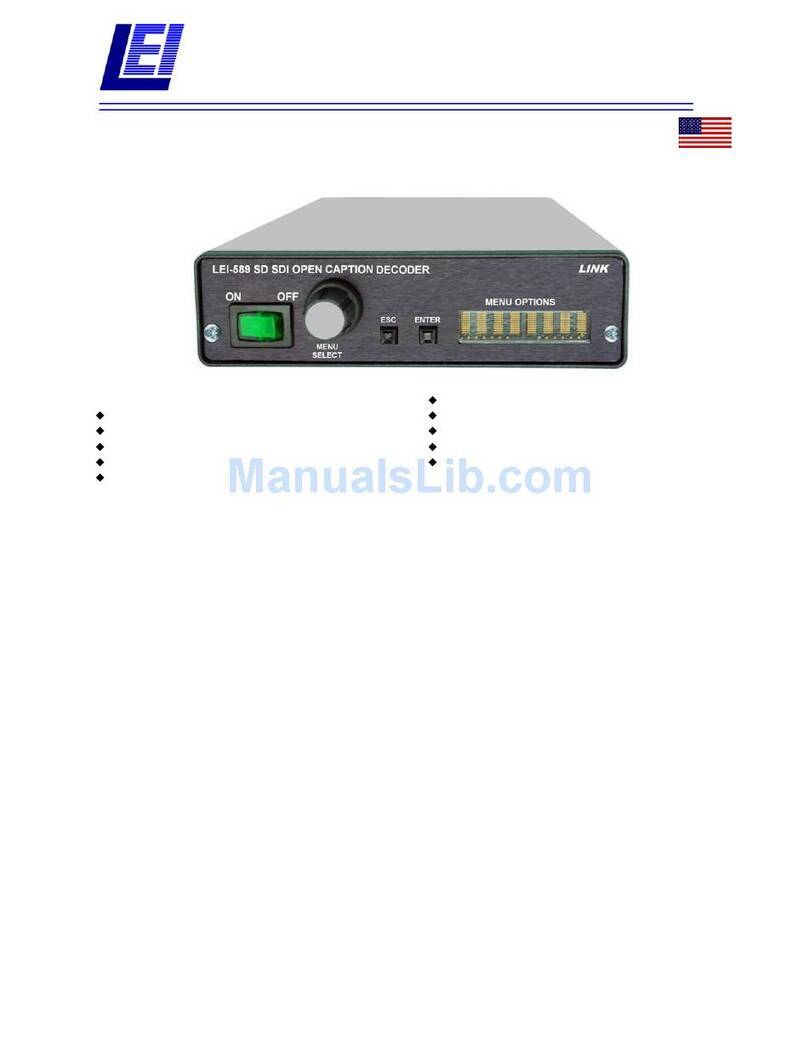
Link
Link SD SDI Open Caption Decoder LEI-589 Specifications
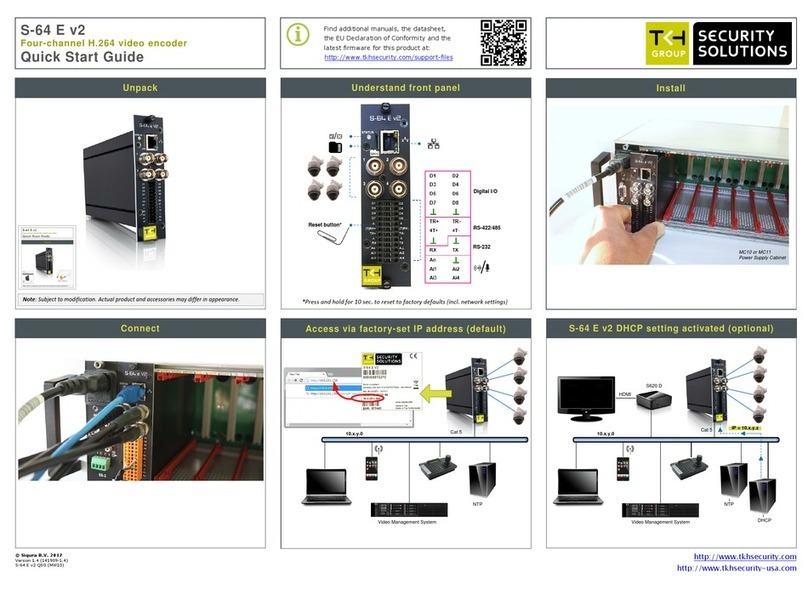
Siqura
Siqura S-64 E v2 quick start guide

Moxa Technologies
Moxa Technologies ME60A Hardware installation guide
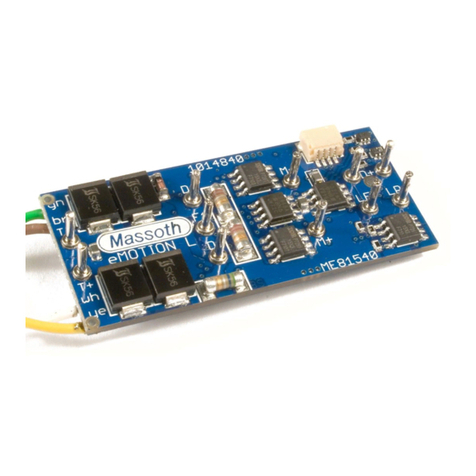
Massoth
Massoth eMOTION M Connection manual
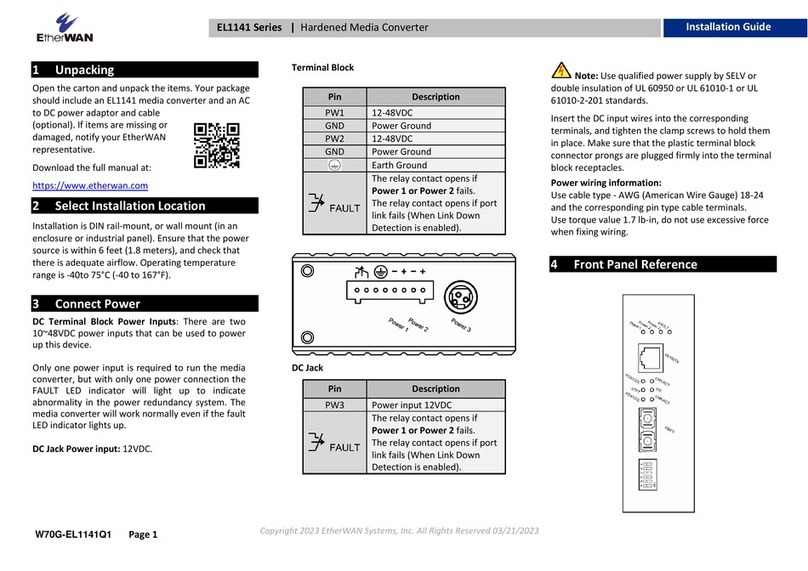
EtherWAN
EtherWAN EL1141 Series installation guide
